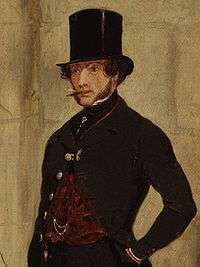Henry Somerset, 7th Duke of Beaufort
Major Henry Somerset, 7th Duke of Beaufort, KG (5 February 1792 – 17 November 1853), styled Earl of Glamorgan until 1803 and Marquess of Worcester between 1803 and 1835,[1] was a British peer, soldier, and politician.
Major His Grace The Duke of Beaufort | |
|---|---|
 The Duke of Beaufort by Henry Alken. | |
| Personal details | |
| Born | 5 February 1792 |
| Died | 17 November 1853 (aged 61) Badminton House, Gloucestershire |
| Nationality | British |
| Political party | Tory |
| Spouse(s) | (1) Georgiana FitzRoy (1792–1821) (2) Emily Smith (1800–1889) |
| Children | 10, including Henry |
| Parents | Henry Somerset, 6th Duke of Beaufort Lady Charlotte Sophia Leveson-Gower |

Background
Beaufort was the eldest son of Henry Somerset, 6th Duke of Beaufort, and Lady Charlotte Sophia, daughter of Granville Leveson-Gower, 1st Marquess of Stafford. Lord Granville Somerset was his younger brother.
Military and political career
Beaufort was commissioned a cornet in the 10th Hussars on 18 June 1811. He was promoted to lieutenant in the 14th Light Dragoons on 21 August, but transferred back to the 10th Hussars on 6 September. Worcester also served as an aide-de-camp to the Duke of Wellington in Portugal and Spain between 1812 and 1814.[1]
In 1813, Beaufort was returned as Member of Parliament (MP) for the Monmouth Boroughs, as a Tory, and continued to hold the seat until 1831. On 26 October 1815, he transferred to the 7th Hussars. In the following year, he was appointed a Lord of the Admiralty under Lord Liverpool, serving on the Board until 1819. On 2 December 1819, he was made a captain in the 37th Foot, and on 30 December, was promoted to the rank of major.[1]
In the contentious election of 1831, Beaufort was defeated by Benjamin Hall at Monmouth Boroughs. While Hall's victory was overturned on petition and Beaufort regained the seat, he again lost to Hall in the 1832 election. He was appointed lieutenant-colonel commandant of the Gloucestershire Yeomanry in 1834.[1] In 1835, he successfully contested West Gloucestershire, but left the House when he succeeded as Duke of Beaufort that November. In 1836, he became High Steward of Bristol and was appointed a Knight of the Garter on 11 April 1842.[1]
Family
.jpg)
Beaufort married Georgiana Frederica Fitzroy (1792–1821), daughter of the Hon. Henry FitzRoy and Lady Anne Wellesley, on 25 July 1814. Georgiana's paternal ancestors included the Schuyler family, the Van Cortlandt family and the Delancey family of British North America. They had three daughters:
- Lady Charlotte Augusta Frederica Somerset (1816–1850), married, on 5 December 1844, Baron Philipp von Neumann (4 December 1781 – 14 January 1851), an Austrian diplomat, by whom she had issue.
- Lady Georgiana Charlotte Anne Somerset (1817–1884), married, in 1836, Christopher Bethell-Codrington, MP (1805–1864) and had issue.
- Lady Anne Harriet Charlotte Somerset (1819-1877), married Colonel Philip James of Dorset
After the death of his wife in 1821, he married her younger half-sister, Emily Frances Smith, daughter of Charles Culling Smith, on 29 June 1822; they were both daughters of Lady Anne Smith, the Duke of Wellington's sister. (This marriage, in contravention of the canon laws of the Church of England, rendered his marriage potentially annullable for many years: for this reason Wellington himself strongly opposed it.) They had seven children, one son and six daughters:
- Henry Charles FitzRoy Somerset, 8th Duke of Beaufort (1824–1899), married Lady Georgiana Charlotte Curzon and had issue.
- Lady Emily Blanche Charlotte Somerset (1828–1895), married George Hay-Drummond, 12th Earl of Kinnoull and had issue.
- Lady Rose Caroline Mary Somerset (1829–1885), who eloped to marry Captain Francis Frederick Lovell.
- Lady Henriëtta Louisa Priscilla Somerset (1831–1863), married John Morant.
- Lady Geraldine Harriett Anne Somerset (1832–1915).
- Lady Katherine Emily Mary Somerset (1834–1914), married Arthur Walsh, 2nd Baron Ormathwaite.
- Lady Edith Frances Wilhelmina Somerset (1838–1915), married William Denison, 1st Earl of Londesborough, and had issue.
In 1840, Beaufort bought the house at 22 Arlington Street in St. James's, a district of the City of Westminster in central London from John Pratt, 1st Marquess Camden and proceeded to expend enormous sums refurbishing the interior of the house. He renamed the house after his title and during his residency it was known as "Beaufort House." He hired architect Owen Jones, who had studied the Alhambra to embellish the interiors. Beaufort sold the house a year before he died to William Hamilton, 11th Duke of Hamilton.[2]
Beaufort died in 1853, aged 61 at Badminton House, Gloucestershire, and was buried at St Michael and All Angels Church, Badminton. He is best known today for his two marriages, and his involvement, as a very young man, with the courtesan Harriette Wilson, to whom he apparently proposed marriage.
Fictional portrayal
Both Beaufort and Harriette Wilson feature as minor characters in Black Ajax by George MacDonald Fraser.
Ancestry
| Ancestors of Henry Somerset, 7th Duke of Beaufort | ||||||||||||||||||||||||||||||||||||||||||||||||||||||||||||||||||||||||||||||||||||||||||||||||||||||||||||||||||||||||||||||||||||||||||||||||||||||||||||||||||||||||||||||||||||||||||||||||||||||||||||||||||||||||||||||||||||||||||||||||||||||||||||||||||||||||||||||||||||||||||||||||||||||||||||||||||||||||||||||||||||||||||||||||||||||||||||||||||||||||||||||||||||||||||||||||||||||||||||||||||||||||||||||||||||||||||||||||||||||||||||||||||||||||||||||||||||||||||||||||||||||||||||||||||||||||||||||||||||||||||||||||||||||||||||||||||||||||||||||||||||||||||||||||||||||||||||||||
|---|---|---|---|---|---|---|---|---|---|---|---|---|---|---|---|---|---|---|---|---|---|---|---|---|---|---|---|---|---|---|---|---|---|---|---|---|---|---|---|---|---|---|---|---|---|---|---|---|---|---|---|---|---|---|---|---|---|---|---|---|---|---|---|---|---|---|---|---|---|---|---|---|---|---|---|---|---|---|---|---|---|---|---|---|---|---|---|---|---|---|---|---|---|---|---|---|---|---|---|---|---|---|---|---|---|---|---|---|---|---|---|---|---|---|---|---|---|---|---|---|---|---|---|---|---|---|---|---|---|---|---|---|---|---|---|---|---|---|---|---|---|---|---|---|---|---|---|---|---|---|---|---|---|---|---|---|---|---|---|---|---|---|---|---|---|---|---|---|---|---|---|---|---|---|---|---|---|---|---|---|---|---|---|---|---|---|---|---|---|---|---|---|---|---|---|---|---|---|---|---|---|---|---|---|---|---|---|---|---|---|---|---|---|---|---|---|---|---|---|---|---|---|---|---|---|---|---|---|---|---|---|---|---|---|---|---|---|---|---|---|---|---|---|---|---|---|---|---|---|---|---|---|---|---|---|---|---|---|---|---|---|---|---|---|---|---|---|---|---|---|---|---|---|---|---|---|---|---|---|---|---|---|---|---|---|---|---|---|---|---|---|---|---|---|---|---|---|---|---|---|---|---|---|---|---|---|---|---|---|---|---|---|---|---|---|---|---|---|---|---|---|---|---|---|---|---|---|---|---|---|---|---|---|---|---|---|---|---|---|---|---|---|---|---|---|---|---|---|---|---|---|---|---|---|---|---|---|---|---|---|---|---|---|---|---|---|---|---|---|---|---|---|---|---|---|---|---|---|---|---|---|---|---|---|---|---|---|---|---|---|---|---|---|---|---|---|---|---|---|---|---|---|---|---|---|---|---|---|---|---|---|---|---|---|---|---|---|---|---|---|---|---|---|---|---|---|---|---|---|---|---|---|---|---|---|---|---|---|---|---|---|---|---|---|---|---|---|---|---|---|---|---|---|---|---|---|---|---|---|---|---|---|---|---|---|---|---|---|---|---|---|---|---|---|---|---|---|---|---|---|---|---|---|---|---|---|---|---|---|---|---|---|---|---|---|---|---|---|---|---|---|---|---|---|---|---|---|---|---|---|---|---|---|---|---|---|---|---|---|---|---|---|---|---|---|---|---|---|---|---|---|---|---|---|---|---|---|---|---|---|---|---|---|---|---|---|---|---|---|---|---|---|---|---|---|---|---|---|---|---|---|---|---|---|---|---|---|---|---|---|---|---|---|---|---|---|---|---|---|---|---|---|---|---|---|---|---|---|---|---|---|---|
| ||||||||||||||||||||||||||||||||||||||||||||||||||||||||||||||||||||||||||||||||||||||||||||||||||||||||||||||||||||||||||||||||||||||||||||||||||||||||||||||||||||||||||||||||||||||||||||||||||||||||||||||||||||||||||||||||||||||||||||||||||||||||||||||||||||||||||||||||||||||||||||||||||||||||||||||||||||||||||||||||||||||||||||||||||||||||||||||||||||||||||||||||||||||||||||||||||||||||||||||||||||||||||||||||||||||||||||||||||||||||||||||||||||||||||||||||||||||||||||||||||||||||||||||||||||||||||||||||||||||||||||||||||||||||||||||||||||||||||||||||||||||||||||||||||||||||||||||||
References
- Doyle, James E. (1886). The Official Baronage of England. Vol. I. Longmans, Green and Co. p. 136. Retrieved 7 March 2009.
- Chancellor, E. Beresford (1908). The Private Palaces of London Past and Present. London: Kegan Paul, Trench, Trübner & Co Ltd. pp. 366–367. Retrieved 30 June 2015.
External links
- Hansard 1803–2005: contributions in Parliament by the Duke of Beaufort
| Parliament of the United Kingdom | ||
|---|---|---|
| Preceded by Lord Charles Somerset |
Member of Parliament for Monmouth Boroughs 1813–1831 |
Succeeded by Benjamin Hall |
| Preceded by Benjamin Hall |
Member of Parliament for Monmouth Boroughs 1831–1832 |
Succeeded by Benjamin Hall |
| Preceded by Hon. Grantley Berkeley Hon. Augustus Moreton |
Member for Gloucestershire West 1835 With: Hon. Grantley Berkeley 1832–1852 |
Succeeded by Hon. Grantley Berkeley Robert Blagden Hale |
| Peerage of England | ||
| Preceded by Henry Somerset |
Duke of Beaufort 1835–1853 |
Succeeded by Henry Somerset |